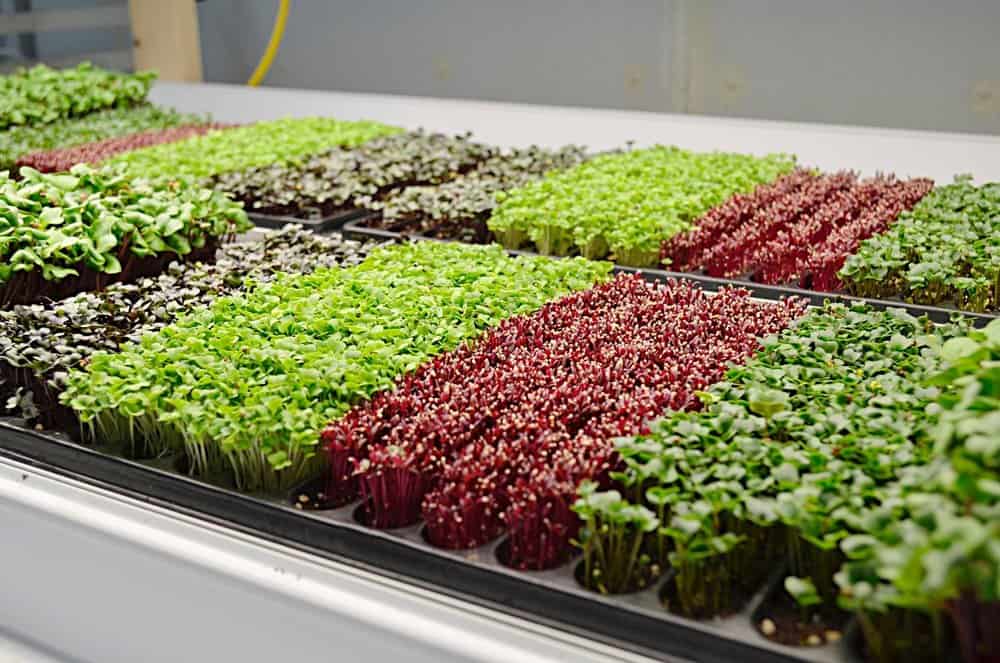Microgreens are of many types, and because there exists a plethora and a wide range of them, it is natural that they require a different set of atmospheric and climatic conditions to grow and thrive. As a microgreens lover myself, I’m aware of the lack of knowledge and awareness around microgreens. And most people that come to me for advice on growing microgreens often ask the same question: what is the best temperature to grow microgreens.
If you’re a new microgreen farmer or an aspiring one, this article is for you. For in it, I’ll talk about what is the best temperature to grow microgreens and the best practices to grow microgreens.
What Is The Best Temperature To Grow Microgreens
The best temperature to grow microgreens varies depending on the type of microgreen you’re growing. For most varieties, the ideal temperature is between 70 and 75 degrees Fahrenheit.
However, some microgreens, such as arugula and mustard greens, prefer cooler temperatures and will do best if grown at 60 to 65 degrees Fahrenheit. And finally, a few microgreens, such as radishes and cabbage, prefer even warmer conditions and will produce the best results if grown at 80 to 85 degrees Fahrenheit.
In general, it’s best to err on the side of cooler temperatures when growing microgreens, as they will still grow at lower temperatures but may become leggy or produce fewer leaves if it’s too warm. By following these guidelines, you can ensure that your microgreens are being grown at the temperature that’s best for them.
I hope you’ve learned something about what is the best temperature to grow microgreens, let’s talk more about it, shall I?

At What Temperature Do Microgreens Thrive?
As I said earlier, the ideal temperature to grow microgreens varies depending on the type of microgreen you’re growing. In general, most microgreens prefer cooler temperatures and will do best if grown at 60 to 75 degrees Fahrenheit.
However, there are a few exceptions to this rule. A few microgreens, such as radishes and cabbage, actually prefer warmer conditions and will produce the best results if grown at 80 to 85 degrees Fahrenheit.
It’s also worth noting that microgreens are very sensitive to temperature changes and can be easily damaged by both too much heat and too much cold. For this reason, it’s important to make sure that your growing area is well-ventilated and that you avoid sudden temperature changes.
What Are The Best Practices For Growing Microgreens?
In addition to knowing the ideal temperature for growing microgreens, there are a few other best practices that you should follow to ensure that your microgreens grow healthy and strong.
Some of the best practices for growing microgreens include:
Using High-Quality Seeds
This is one of the most important factors for growing healthy microgreens. Make sure to use fresh, high-quality seeds from a reputable supplier.

Starting With Clean Equipment
All of your equipment should be clean and sterilized before you start growing. This includes your pots, trays, soil, and any other materials that will come into contact with your microgreens.
Providing Adequate Drainage
Microgreens need well-drained soil to thrive. Be sure to use a potting mix that contains perlite or vermiculite to ensure good drainage.
Watering Properly
Microgreens should be watered regularly, but be careful not to overwater them. The soil should be moist, but not wet. allow the top layer of soil to dry out between waterings.
Fertilizing Microgreens
Microgreens don’t need a lot of fertilizer, but you can give them a light feeding every couple of weeks with a weak solution of liquid fertilizer.
Harvesting Microgreens
Microgreens are ready to harvest when they have at least two sets of true leaves. Using sharp scissors, cut the microgreens at the base of the stem, just above the soil line.
These are just a few of the best practices for growing microgreens. By following these guidelines, you can ensure that your microgreens are healthy and grow well.
Can Microgreens Grow In Hot Weather?
Microgreens are miniature versions of common vegetables and herbs that are usually harvested 10 to 14 days after planting. They are grown in soil or hydroponically and can be harvested by cutting them at the base with scissors. Microgreens are high in vitamins, minerals, and antioxidants, and they can add flavor, color, and texture to salads, sandwiches, and other dishes. Many people wonder if microgreens can grow in hot weather.
The answer is yes! Microgreens can tolerate higher temperatures than mature plants, making them ideal for growing in hot weather regions. However, it is important to water microgreens regularly to prevent them from wilting. In addition, you may need to provide some shade if the temperatures become too hot.
With a little care, you can successfully grow microgreens in hot weather conditions.
How To Take Care Of Microgreens In Extreme Weather Conditions?
Microgreens are a type of vegetable that is harvested early, typically when they are about 2-3 inches tall. Despite their small size, microgreens pack a big nutritional punch and are often used as a garnish or salad ingredient. Because they are so delicate, microgreens can be difficult to grow in extreme weather conditions. Here are some tips for taking care of microgreens in hot or cold weather:
If the temperature is below freezing, make sure to protect your microgreens with a layer of mulch. This will help to insulate the plants and prevent them from being damaged by the cold.
In hot weather, make sure to water your microgreens regularly. They will need more water than normal to prevent wilting and stress. If possible, try to grow them in a shady spot to protect them from the harsh afternoon sun.
With a little bit of extra care, you can successfully grow microgreens even in extreme weather conditions. By following these tips, you can enjoy fresh, nutritious greens all year round!
Conclusion
The ideal temperature to grow microgreens differs depending on the type of plant. For example, mustard greens thrive in cooler temperatures between 60-70 degrees Fahrenheit, while beet greens prefer it a bit warmer at 70-80 degrees.
In general, most microgreens do best in a temperature range of 60-80 degrees Fahrenheit with some air circulation. If the growing area is too hot or too cold, plants will begin to bolt or produce flowers instead of leaves.
By providing the right temperature, you can ensure that your microgreens will be healthy and tasty. And, with this, I hope you know what is the best temperature to grow microgreens.
